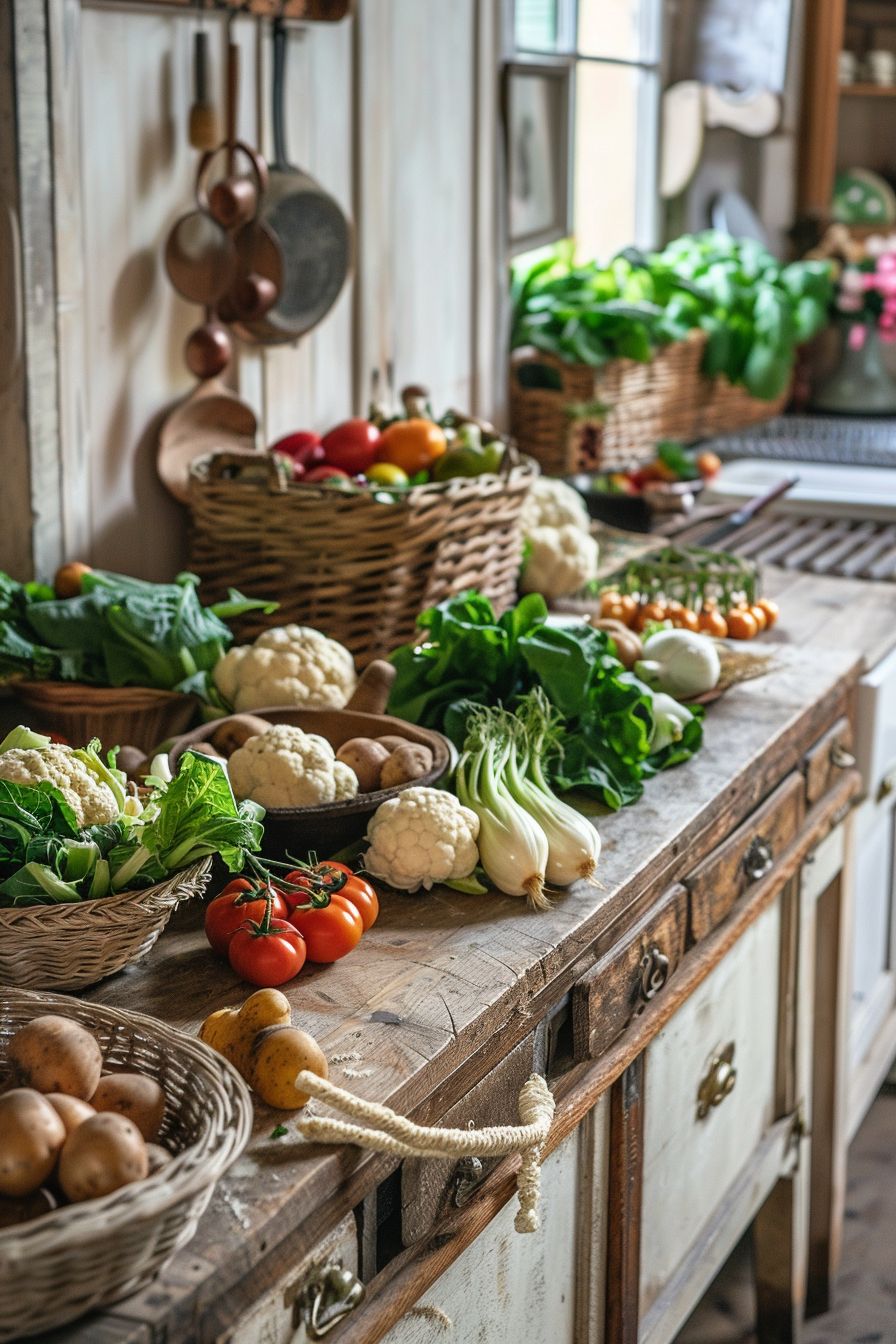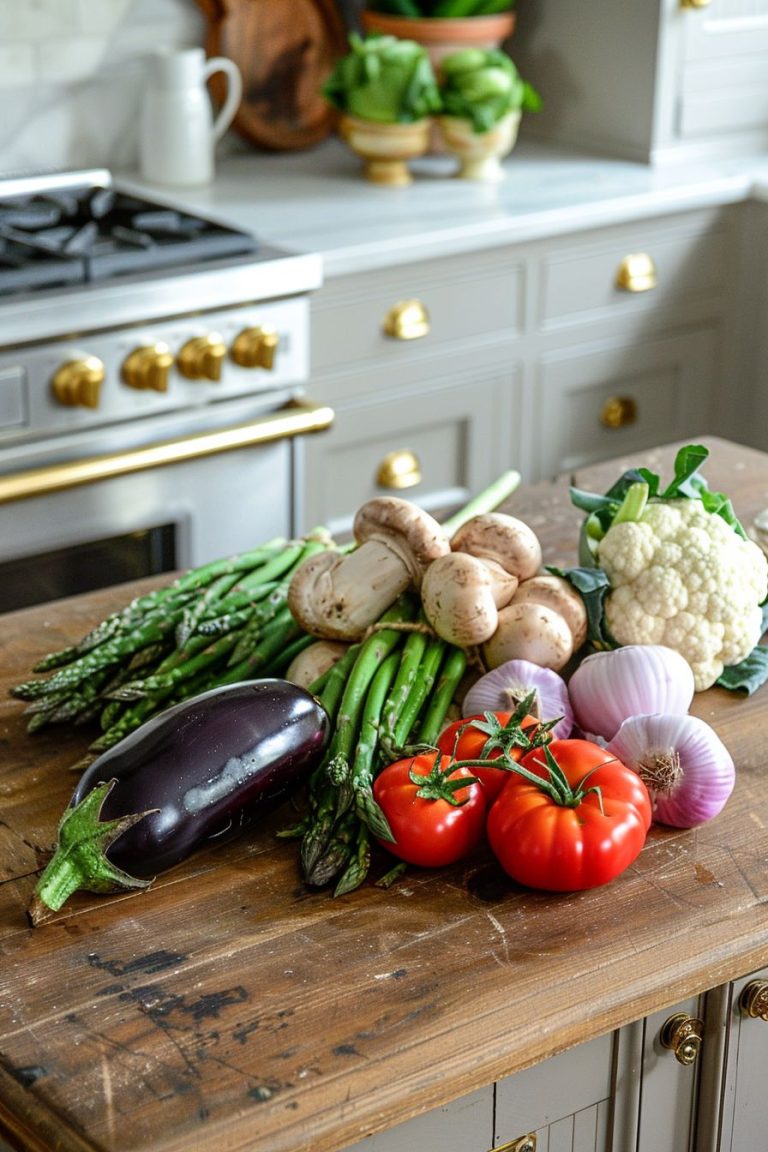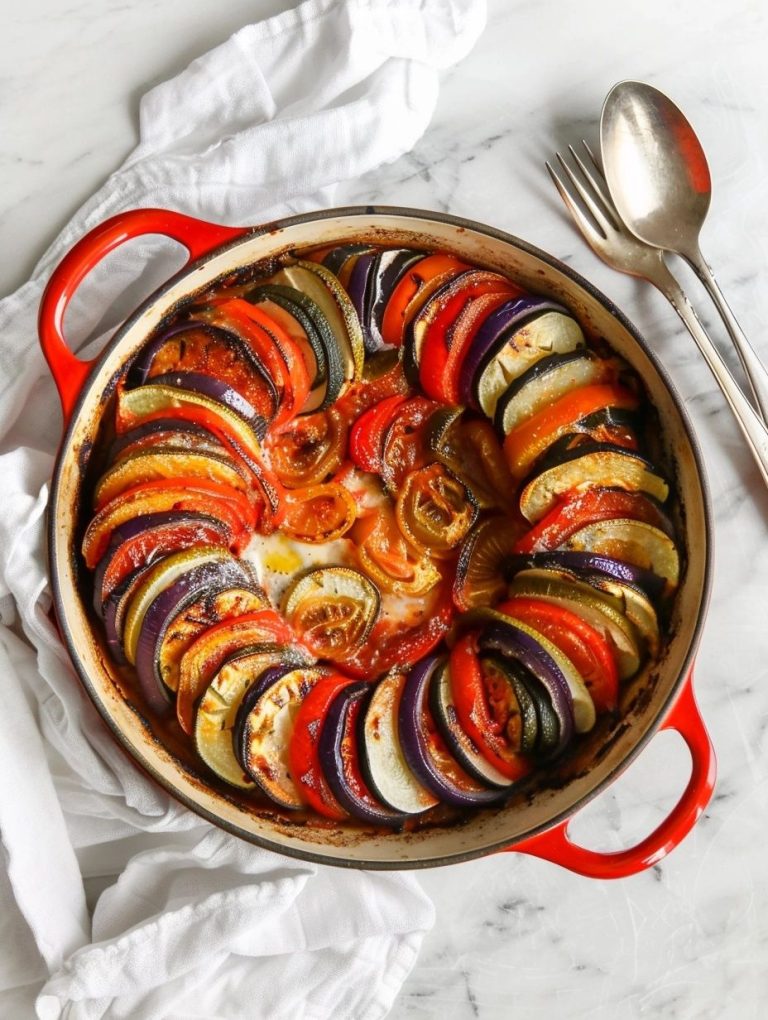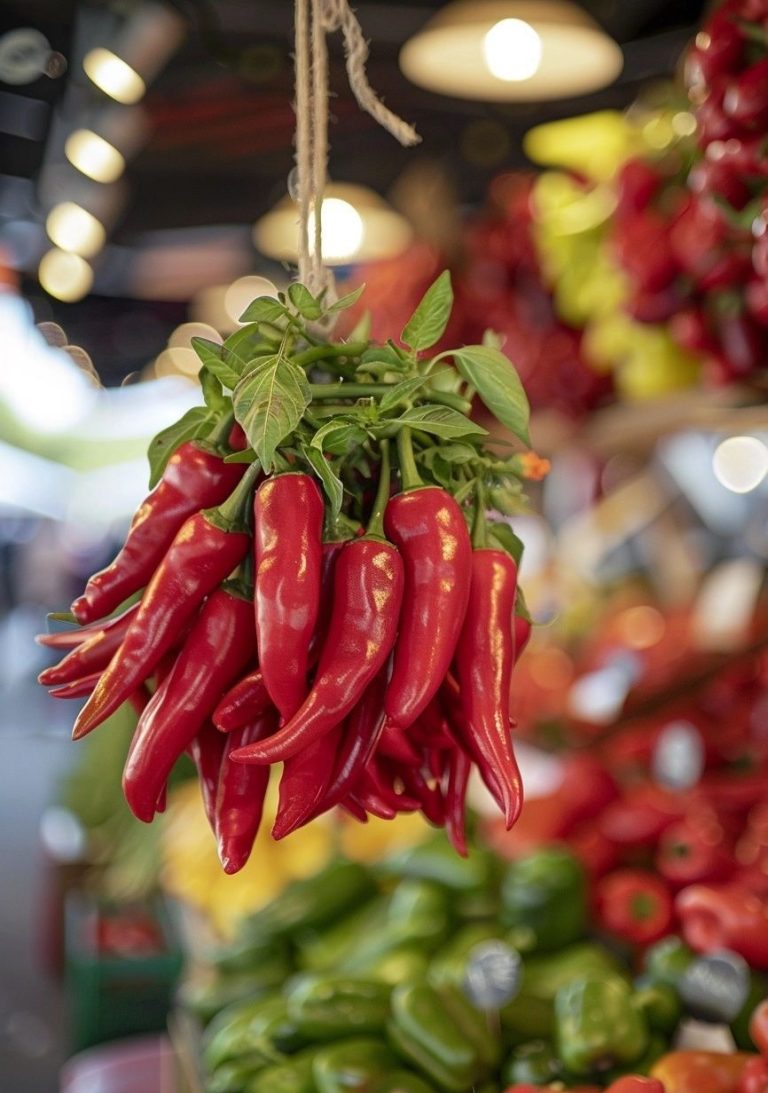37 Most Popular Vegetables in France
We may earn a commission through all links on this website. As an Amazon Associate, we earn from qualifying purchases.Bonjour, guys! Ever wonder what are the most popular vegetables in France?
This time we’re taking a delightful detour to the charming countryside and bustling city markets of France, a country we all know is universally celebrated for its timeless culinary traditions and tantalizing treats.
France’s kitchens overflow with a cornucopia of ingredients, each contributing to the exceptional richness of its gastronomic scene. And today, we’re going to focus on a vital but often underrated aspect of French cuisine: the vegetables.
Ah, the humble légume (vegetable).
In France, vegetables are so much more than mere accompaniments. They are the stars that light up a meal, the strokes of color that complete a beautiful canvas of flavor.
From the sun-kissed tomato vines of Provence to the hearty leeks of Brittany, vegetables play a significant role in painting France’s diverse culinary landscape.
And though the French have a flair for transforming even the simplest ingredient into a gourmet delight, the most popular vegetables tell a story of the country’s regional tastes, culinary creativity, and close relationship with the land.

In this post, we’re going to explore the most loved vegetables in French cooking, not just as individual ingredients, but as vibrant threads in the rich tapestry of French gastronomy.
From everyday family meals to gastronomic restaurants, we’ll unravel the art of selecting, preparing, and enjoying these earthy delights, just like the French do.
So grab your apron, sharpen your knives, and prepare to immerse yourself in a beautiful world of color, texture, and taste. Let’s get cooking, à la Française!
Lettuce
Lettuce, or “la laitue” as it’s known in France, is a staple in the French diet. It finds its place on most dinner tables, either as a simple side salad or as an ingredient in a more elaborate dish. The French favor several varieties such as Batavia, a frilly, crisp lettuce, or the sweet and buttery Boston lettuce. Whether it’s a simple drizzle of vinaigrette over fresh leaves or a delicately composed Salade Niçoise, lettuce’s refreshing crispness offers a delightful contrast to other rich, hearty French dishes.
Mesclun
“Mesclun” is not a single vegetable, but a traditional mix of tender young salad greens. Originating from Provence, mesclun typically includes lettuce, dandelion, arugula (rocket), spinach, chervil, and sometimes edible flowers. Its flavor profile ranges from mild to slightly peppery, offering distinct textures and tastes in every bite. It’s a common feature in spring and summer meals, celebrated for its freshness and diversity of flavors.
Mâche
Also known as lamb’s lettuce or corn salad, “mâche” is a popular salad green with a distinctive nutty flavor and a soft, buttery texture. Its dark green, spoon-shaped leaves often grace French salads during the winter months. Mâche is also commonly paired with beets, walnuts, or goat cheese, creating a satisfying balance of earthy flavors and textures.
Arugula
“Roquette” or arugula, with its peppery flavor, is a favorite in the French culinary scene. It’s often used in salads, pasta dishes, or as a pizza topping after the baking process. Arugula’s sharpness adds a kick that enlivens dishes and complements richer ingredients like cheese or meats. It is also a crucial component in the aforementioned mesclun mix, contributing to its distinctive taste.
Spinach
In France, “épinards” or spinach is much more than a side dish. It’s used in everything from simple salads to quiches, soufflés, and gratins. Its sweet, slightly earthy flavor pairs beautifully with cream, cheese, and eggs, which feature heavily in French cuisine. When in season, fresh spinach leaves can often be found in the classic Salade de chèvre chaud, where they provide a fresh balance to warm, melty goat cheese.
Cabbage
The humble “chou”, or cabbage, is a beloved vegetable in the French culinary repertoire, especially in winter. From the tender chou vert (green cabbage) to the colorful chou rouge (red cabbage), each variety brings something unique to the table. Whether it’s in a comforting potée (stew), a rustic choucroute (sauerkraut), or a delicate Choux farci (stuffed cabbage), this versatile vegetable is a symbol of French country cooking at its finest.
Watercress
Watercress, known in France as “cresson,” is a popular green leafy vegetable in French cuisine. It is often found in soups, salads, and sauces due to its distinct peppery flavor. This vegetable is notably rich in vitamins and minerals, particularly vitamins A and C. Watercress is typically harvested in the spring, which gives it a special place in seasonal French cooking. Watercress soups and salads are considered classic dishes in Normandy, highlighting the regional preferences that characterize the diverse culinary landscape of France.
Endive
The endive, or “chicorée” as it is called in French, is a staple vegetable in France due to its versatility. Its crisp leaves, with their characteristic slightly bitter taste, are often served both raw in salads or cooked in dishes. The endive’s popularity can also be attributed to its availability throughout the year, making it a reliable addition to any meal.
Belgians introduced endive cultivation to France in the 19th century, and since then, it has grown to be a beloved component of French gastronomy, with dishes like Endives au jambon (ham-wrapped endive) being a comforting, everyday meal in many French homes.
Cucumber
Cucumber, “concombre” in French, is a cool and refreshing vegetable that features prominently in French cuisine, particularly during the warmer months. Although cucumbers are often associated with salads, they are also commonly used in French gazpacho, pickled for cornichons, or even included in sandwiches and tartines. The French variety of cucumber is often smaller and less watery than its counterparts in other countries, offering a more concentrated flavor and a pleasing crunch. This vegetable is a summer staple in French markets, and its popularity underlines the French appreciation for fresh, seasonally appropriate ingredients.
Broccoli
While broccoli, or “brocoli,” may not traditionally be associated with French cuisine, its popularity has been steadily increasing in recent years. This cruciferous vegetable is packed with vitamins and nutrients, contributing to its rising status as a health food. Broccoli can be found in simple sautés or more complex quiches and gratins, offering a vibrant color and a unique texture. Furthermore, with the increasing influence of international cuisine, broccoli consumption in France has grown, demonstrating the country’s evolving culinary tastes.
Cauliflower
Cauliflower, known as “chou-fleur” in French, is another well-liked vegetable in France. Its mild flavor and versatile texture make it suitable for a multitude of dishes, from the classic “gratin de chou-fleur” (cauliflower gratin) to the more contemporary cauliflower rice, reflecting the breadth of French culinary innovation. Cauliflower is especially popular in the cooler months, as it is a hearty vegetable that pairs well with rich, warming flavors. With its significant nutritional benefits and culinary versatility, cauliflower holds a special place in the French kitchen and is a testament to France’s love for vegetables in all their varied forms.
Brussels Sprouts
In France, brussels sprouts, known as “choux de Bruxelles,” have long been a popular choice, especially in the cooler months. These small, leafy green vegetables, are known for their distinctive flavor, which can range from sweet to nutty. While they are delicious when simply roasted with some olive oil, salt, and pepper, they can also be found in French dishes, such as hearty stews and gratins. The popularity of Brussels sprouts in France can be attributed not only to their versatility in cooking but also to their high nutrient content, including a significant amount of vitamins C and K.
Celery
Celery, or “céleri” in French, is a staple in many French dishes, both for its taste and for the aromatic qualities it brings to recipes. It forms part of the classic French mirepoix — a combination of chopped celery, onions, and carrots used as a base in a multitude of dishes. Celery is enjoyed both raw, often as a snack or in salads, and cooked in soups, stews, and casseroles. Its crunchy texture and fresh flavor contribute to its popularity, making it an essential component in the French culinary landscape.
Asparagus
Asparagus, known in French as “asperge,” holds a place of honor in France, especially during its short spring season. The French enjoy asparagus in a myriad of ways, from simply steamed with a side of hollandaise sauce to being incorporated into sophisticated dishes like asparagus risotto or tart. In France, white asparagus is particularly prized for its delicate flavor and is often considered a gourmet ingredient. Whether green or white, asparagus signifies the arrival of spring in France and is a much-anticipated highlight in seasonal cooking.
Leeks
Leeks, or “poireaux” in French, are one of the most cherished vegetables in the country. Their mild, sweet, and slightly onion-like flavor makes them a versatile ingredient in a multitude of French dishes, such as the classic potage parmentier (leek and potato soup) or tarte aux poireaux (leek tart). Leeks can be enjoyed year-round, but they are at their best from fall to spring. This humble vegetable is a key element in French cuisine, demonstrating how simple ingredients can be transformed into deeply satisfying dishes.
Zucchini
Zucchini, known as “courgette” in French, is a summer squash that is beloved in France. Its mild flavor and soft texture when cooked make it a versatile vegetable that can be used in a wide range of dishes, from ratatouille to zucchini gratin, to stuffed zucchini. It can also be eaten raw in salads, offering a refreshing crunch. Given its adaptability, zucchini is a testament to the French philosophy of embracing seasonal ingredients and utilizing them to their fullest potential.
Squash
In French cuisine, squash, known as “courge,” is highly appreciated for its versatility and nutritional benefits. Squashes of all sorts, from butternut to spaghetti squash, can be found in traditional and contemporary French dishes alike. Particularly in autumn and winter, squash-based dishes like creamy soups, hearty gratins, and even desserts like squash clafoutis gain prominence. This vegetable’s popularity reflects the French culinary principle of seasonality, as well as the ability to transform simple ingredients into culinary masterpieces.
Potatoes
Potatoes, or “pommes de terre” in French, are a staple of French cuisine and are arguably one of the most popular vegetables in the country. From pommes frites (French fries) to gratin dauphinois (a creamy potato dish from the Dauphiné region), the potato’s versatility is undeniable. The French are particularly known for using vitelotte potatoes and bonnotte potatoes in their recipes.
They are enjoyed in both rustic, comfort-food recipes and more refined, gourmet dishes, underlining their universal appeal. The widespread cultivation of potatoes in France further supports their constant presence in the French diet, highlighting their fundamental role in the culinary tradition of the country.
Yam
Yam, known as “igname” in French, is less common in traditional French cuisine but has been gaining popularity, particularly as French palates have grown more diverse and globalized. Yams are tuberous vegetables often compared to sweet potatoes, though they are different. They can be prepared in many of the same ways as potatoes, making them a familiar yet novel addition to many dishes. This shift towards ingredients such as yams showcases how French cuisine continues to evolve and incorporate influences from around the world.
Pumpkin
Pumpkin, or “citrouille” in French, is a beloved autumnal vegetable. Whether in soups, gratins, or desserts like the traditional tarte à la citrouille (pumpkin tart), pumpkin’s rich, sweet flavor and creamy texture make it a star ingredient in many dishes. While pumpkins are a universal symbol of fall, they have a particular resonance in French cuisine due to the importance placed on seasonality. Furthermore, the iconic image of a pumpkin can be found in French folklore and fairy tales, underscoring the cultural as well as culinary significance of this vegetable.
Carrots
Carrots, known as “carottes” in French, are an essential vegetable in France. They are a primary ingredient in mirepoix, a fundamental base used in a wide range of French dishes. Carrots can be found in salads, soups, stews, and side dishes, showcasing their versatility. With their sweet, slightly earthy flavor, carrots appeal to many tastes and can be enjoyed raw or cooked. Their popularity underscores the preference in French cuisine for vegetables that bring both taste and nutrition, making them a classic mainstay in the French culinary canon.
Onions
Onions, or “oignons” in French, are a fundamental part of French culinary tradition. They form the base of countless French dishes, from simple sauces to elaborate stews. Known for their capacity to enhance the flavor of dishes, onions are also celebrated in their own right in beloved specialties such as soupe à l’oignon, referred to as French onion soup in America. Whether enjoyed for their sweet, caramelized flavor in a tarte Tatin or for their sharp bite when used raw in salads, onions are undeniably a cornerstone of French cuisine.
Garlic
Garlic, known as “ail” in French, is one of the most beloved ingredients in French cooking. Its pungent flavor is key to many iconic dishes such as bouillabaisse, coq au vin, and ratatouille.
A simple combination of garlic and butter transforms into the delectable Escargots de Bourgogne, or Burgundy snails, highlighting garlic’s role in creating France’s most iconic gastronomic experiences.
It is not only favored for its taste but also its health benefits, contributing to its omnipresence in the French culinary landscape.
Shallots
Shallots, or “échalotes” in French, are a popular ingredient due to their delicate, slightly sweet flavor, which is less harsh than that of onions. They are often used in French cooking for their ability to subtly enhance a dish without overpowering it.
Whether sautéed in butter for a sauce, used raw in vinaigrettes, or cooked in a traditional coq au vin, shallots bring an element of refined flavor that has helped secure their popularity in French cuisine.
Radishes
Radishes, known as “radis” in France, are a popular vegetable enjoyed for their crunchy texture and peppery flavor. A classic French appetizer is radishes served with bread, butter, and a pinch of salt. Radishes are also commonly included in salads or used as a garnish, adding a vibrant color and a unique bite. Their popularity particularly in the spring, when they are at their peak, showcases the French tradition of seasonality in eating.
Turnips
Turnips, or “navets” in French, are a traditional root vegetable often associated with rustic, country cooking. They are typically used in hearty stews and soups like pot-au-feu, but can also be served glazed as a side dish. Turnips have a slightly sweet and earthy flavor, and both the root and the greens are edible, fitting the French ethos of using ingredients to their fullest potential.
Artichoke
The artichoke, or “artichaut” in French, is a popular vegetable celebrated for its unique flavor and texture. Artichokes can be enjoyed steamed and served with a vinaigrette, stuffed, or even in the famous artichokes à la barigoule, a traditional Provençal side dish. The artichoke’s distinctive, slightly nutty flavor has secured its place in French cuisine, where it is appreciated as much for its taste as for its nutritional value.
Beetroot
Beetroot, known as “betterave” in French, is a versatile and nutritious vegetable. It can be enjoyed cooked or raw, in salads, soups, or even as a side dish. Its sweet, earthy flavor and vibrant color make it a popular choice for dishes from the simple Salade de betteraves to the more sophisticated beetroot carpaccio. The widespread cultivation and consumption of beetroot in France underline its importance in the French vegetable pantheon.
Eggplant
Eggplant, or “aubergine” in French, is a favorite summer vegetable. Its silky texture when cooked and its ability to absorb flavors make it ideal for a range of dishes. The most famous of these is likely Ratatouille, a vegetable medley where eggplant stars alongside zucchini, bell peppers, and tomatoes. Eggplant’s popularity in France can also be seen in dishes like “caviar d’aubergine,” a delicious spread made from puréed eggplant.
Tomatoes
Tomatoes, “tomates” in French, are a quintessential part of French cuisine. They feature prominently in a myriad of dishes, from fresh salads and gazpacho in the summer to sauces and soups in the winter. Varieties like Marmande and Coeur de Boeuf, known for their superior flavor, reflect the French passion for quality produce. This fruit, often treated as a vegetable in cooking, is a symbol of the Mediterranean influence on French cuisine and the importance of fresh, seasonal ingredients in French culinary culture.
Mushrooms
In France, mushrooms, or “champignons,” hold a special place in the kitchen and the culture. The country boasts an impressive variety of wild and cultivated mushrooms, such as morels, chanterelles, and button mushrooms. They are utilized in a plethora of dishes, from simple omelettes to the classic Coq au vin. Foraging for mushrooms in the French countryside is a popular autumn activity, reflecting the deep connection between French cuisine and the natural environment.
Truffles
Truffles are considered a culinary luxury in France. Known as “truffes,” these fungi are appreciated for their intense aroma and unique, earthy flavor. The Périgord black truffle and the Provençal white truffle are among the most prized varieties. Used sparingly due to their high price, truffles are typically shaved over dishes like pasta, risotto, and eggs, instantly elevating them to gourmet status. Truffle hunting, particularly in regions like Périgord and Provence, is a cherished tradition that attests to the high regard for this exceptional ingredient in French cuisine.
Cèpes
Cèpes, also known as porcini mushrooms, are a beloved variety in France. They are known for their robust flavor and meaty texture, which make them a standout ingredient in dishes like “boeuf bourguignon” or simply sautéed with garlic and parsley. Cèpes are often foraged in the wild during the autumn months, but they can also be cultivated. Their popularity underscores the importance of fungi in French cuisine and the French penchant for ingredients that connect food with the rhythms of nature.
Peppers
Peppers, or “poivrons” in French, are an essential part of many regional dishes, particularly in the south of France, where the climate is conducive to their growth. Whether enjoyed raw, roasted, or stuffed, peppers bring a splash of color and a burst of flavor to the French table, encapsulating the vibrant spirit of French cuisine.
They are a key ingredient in the classic Ratatouille, and the mild, sweet flavor of red and yellow varieties adds depth to salads, stews, and roasted vegetable medleys.
The Espelette pepper is a popular pepper that is grown in the Basque region of France.
The Cayenne pepper is another popular pepper variety that comes from the French overseas territory of French Guiana. The pepper was named after the region’s capital city.
Green Beans
Green beans, known as “haricots verts” in French, are a popular vegetable in France, celebrated for their delicate flavor and versatility. They are a common sight in salads, such as “salade niçoise,” and as a side dish, often simply steamed and tossed with butter and herbs. Green beans are also a staple ingredient in Cassoulet, a hearty bean stew from southern France. The wide use of green beans in French cuisine underscores their status as a much-loved vegetable!
Peas
Peas, or “petits pois” in French, are a cherished springtime vegetable. They are enjoyed for their sweet flavor and tender texture, which make them delightful in salads, soups, ragouts, and side dishes. A classic French dish is Petits pois à la française, where peas are gently cooked with lettuce, onions, and herbs. The anticipation for the arrival of fresh peas each spring demonstrates the importance of seasonality in French cuisine.
Corn
Corn, or “maïs” in French, is less commonly found in traditional French cuisine but has become increasingly popular, particularly as a grain or as popcorn. Sweet corn, eaten off the cob, is more of a novelty in France and is generally seen as an American food. Nevertheless, corn’s versatility has led to its use in salads and cornmeal-based dishes like the French version of Polenta. The adoption of corn reflects the evolving nature of French cuisine and its capacity to incorporate new ingredients into its repertoire.



